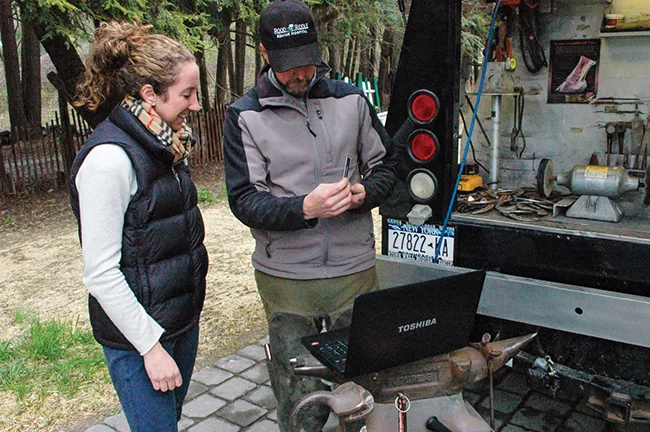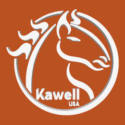The 21st century has seen incredible advances in computer technology that has radically transformed society. The proliferation of handheld devices alone revolutionized communication and how people work.
The impact of computers and programs developed for them is apparent in how farriers operate their practices. More footcare practitioners are opting for sophisticated programs accessible from multiple devices instead of the traditional farrier accounting systems of ledgers, notebooks and shoeboxes full of receipts.
Certainly, you could use handwritten records and invoices to maintain your business. A notebook is only a few bucks and you can find inexpensive invoice pads at most office supply stores. Traditional does not mean obsolete, and an antiquated system is better than no system at all.
However, when you measure the efficiency, resourcefulness and peace of mind offered by computer-based programs (desktop, laptop and handheld) to that of a traditional system, computers are the smarter choice. Because of the many benefits, it makes more sense to utilize this technology at the early stages of your practice rather than after you have already established one.
The Essentials
Before you begin, understand what minimum information you should track in your footcare practice:
1. Client information. This includes your clients’ names, home addresses, phone numbers and email addresses. Include home, mobile and work numbers from clients. Having a collected database of client email addresses is helpful should you need to simultaneously contact multiple clients on issues such as achieving certification or if you change your phone number.
2. Horse information. Here, you’ll list the horses, their owners, when the horses were last worked on and what they will need next time. The latter will be important for when you need to bring equipment on the barn call the next visit.
Be detailed about what you did with each horse, as it will help you provide the client with a detailed invoice. You may want to include other information here, such as the client’s preferred veterinarian.
3. Income. For each client, list the money you have made, as well as what you are still owed. Be sure to record the dates for when you notified the clients of any outstanding bills.
4. Expenses. Detail how much you have spent on each job and on what items. Account for everything from the nails driven to the shoes used to pads or any other extra item. It is important to be detailed on what you have done for each horse, as it will help you itemize what you spent per horse when trying to understand your overall costs.
Based in West Sussex, England, David Nicholls has been involved with farriery for 46 years. He runs a multifarrier practice and was an early adapter of computer-based technology in his business. He switched to computerized recordkeeping after losing his handwritten records twice.
Speaking from his experience with farrier-specific software (Farriers Manager), Nicholls says before beginning any record or invoicing system, you also establish the variables for your practice.
“First, enter some information into the accounting part of any software, including how much you charge for a trim, new set of shoes, material costs, retail figures and so on,” he says.
Detail is crucial when inputting client and horse information, according to Nicholls, including horseshoe sizes and specific shoeing needs.
Understanding What’s Available
There are many computer-based options available for records and invoicing. It will make keeping thorough records easier by using farrier-specific software.

For ease of use, look for providers for handheld solutions and cloud-based storage. Why? You likely have the primary tool in your hand already.
According to the Pew Research Center, 83% of people ages 18 to 29 own a smartphone. That number will climb in the coming years. Tablet usage is not as widespread at 50% among this demographic, but Pew experts also predict usage to grow.
These numbers tell that handheld devices are the norm, both for farriers and clients. Handheld devices are crucial for phone, email, photography, scheduling and other applications. It makes sense to utilize it further for your business.
While you should find a program that fits your needs, John Fligg of Ambrit Software says that selecting a program based only on the user’s known needs may leave some benefits unrecognized. For instance, if scheduling is the only goal, the user may fail to realize other features within the software that can improve business practices. Examine all features available and consider how they can help your footcare business.
Fligg adds that the biggest mistake users can make when using new software is ignoring software tutorials. By rushing through a program without an understanding, the user may be left with a poor experience, and subsequently blames the software for shortcomings when actually the problem is user error.
How Much Is Your Time Worth?
Nicholls quickly saw the positive impact that recordkeeping software had on his time investment. The British farrier has identified several time-saving benefits from using software to manage his business:
- No need for duplicate entries.
- Easy access to notes about veterinary referrals he has worked on to impart factual information to the owner’s usual farrier.
- Quickly generate financial reports.
- Easy monitoring of stock use and inventory.
- Immediate and sharing of access to information on the horses needed by both veterinarians and insurance companies.
- By containing all information (X-rays, veterinarian reports, etc.) in one place, he can quickly call information to discuss cases. This has increased future referrals due to client recognition of competence.
- Ability for financial planning, forecasting expenses, etc.
Along with a laptop, Nicholls also uses a portable printer in his shoeing rig, noting that it takes up very little space. His program is accessible from both his laptop or mobile devices.
He recommends developing the habit of entering information at the end of each appointment.
“I have no problem committing to inputing the information at each stop,” Nicholls says. “You have to generate and print an invoice anyway, and do that from the information already in the program. Using software looks professional and sets you apart from the others.”
Better Client Relations
Clients will be impressed with your creation and access to records, but Nicholls has found a way to further engage them. By having clients input some information, you solidify their role as a team member rather than simply that as a customer.
“I just input the client name and ask them to input all the horse and personal information,” Nicholls says. “Or I get them to put all of that information on a printed form that replicates the software. I then input that at the end of each day.”
Many of his clients are happy to input the information.
“I found, overall, these clients loved to do this and become involved, especially keen when you either have additional information or they get a new horse,” he says. “You can store pictures, videos, reports and much more, so you have a complete record of each client and horse.
“This is useful if there is any dispute regarding your work. You can show clients positive progress in improving their horses’ feet or the condition they are suffering from. This is great for keeping clients happy and marketing yourself as a top professional at the same time.”
Prompt Payments
Computer technology offers solutions to a problem that has hurt every farrier practice at one time: being paid by the client. Various options allow you to email or print an invoice, while other services allow a farrier to swipe a client’s credit card using a card reader attached to a mobile device. Electronic invoicing provides a solution for the client who isn’t at the barn.
“At the end of the day, the farrier has to get paid,” says Cindi Stanley, director of operations and customer service for Paynet Systems. “An electronic invoice with a ‘click-to-pay’ button allows customers to pay from their desktop or mobile device.”
Nicholls regularly emails clients invoices straight from the program. “More clients at barns are at work these days, and requests for these are becoming more prevalent,” he says.
Clinton Corners, N.Y., farrier Taylor Keenan uses both electronic invoicing and a card reader attached to his smartphone in his farrier practice. He agrees that electronic invoicing is beneficial, but finds immediate collection by using a card reader attached to his smartphone had an immediate impact. Within a few months, his delinquent payments decreased by 60% thanks to on-site credit card payment.
“Why should farriers accept being paid days or weeks after providing the service?” asks Keenan. “Your mechanic demands payment after repairing your truck.”
Don’t look at mobile invoicing and payments only from your perspective of being paid promptly or improved professionalism. You also are providing the clients with conveniences.
First, you are providing a service that a client is accustomed to. Whether at a brick-and-mortar store or an online retailer, few businesses don’t accept credit cards. You allow the purchase behavior clients expect.
It also offers a convenient way for clients to pay, either at the barn using a card reader or remotely from their desktop or handheld device. They don’t need cash on hand or to remember to bring a checkbook.
By paying by credit card, clients will have several weeks until they need to reimburse the bank that issued the credit card. They may not have the available funds in a bank account at the time of your service. Therefore the client views it as a convenience, but it also ensures your prompt payment.
In the end, technology should improve our lives. Whether a desktop or handheld device, there are recordkeeping and invoicing programs that do just that for both the farrier and client. Make the commitment now to make these solutions part of your practice. It beats chasing down clients for checks or sifting through a shoebox for a missing invoice.








